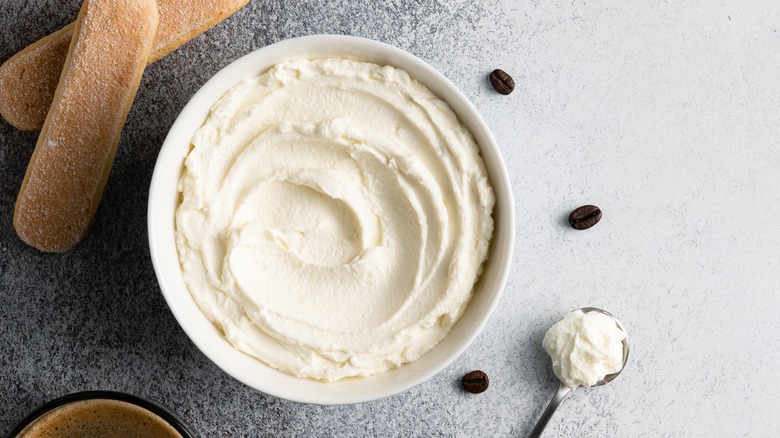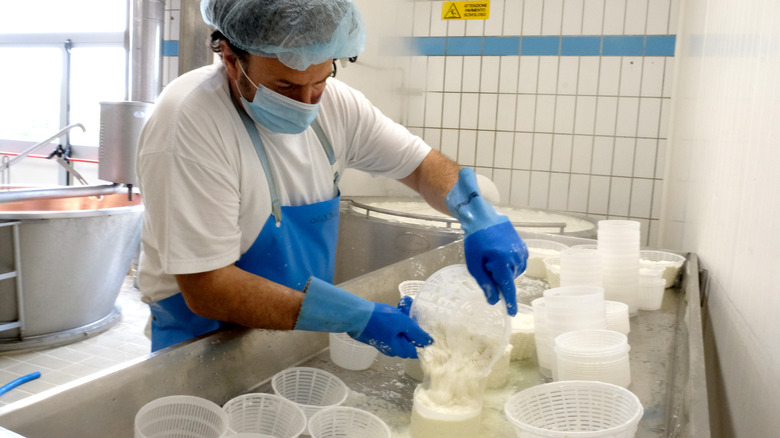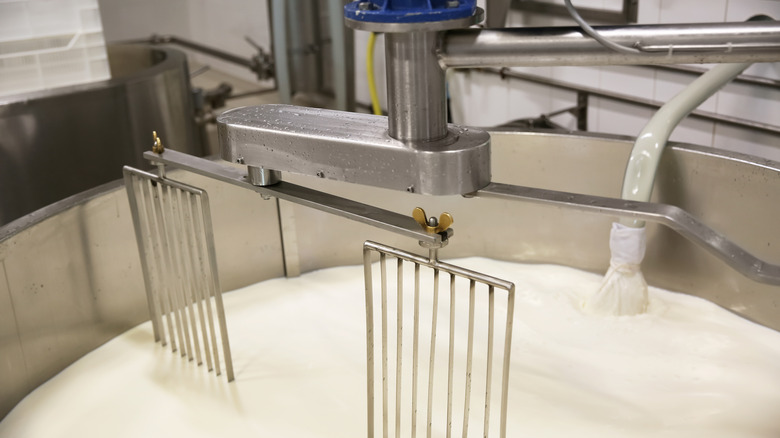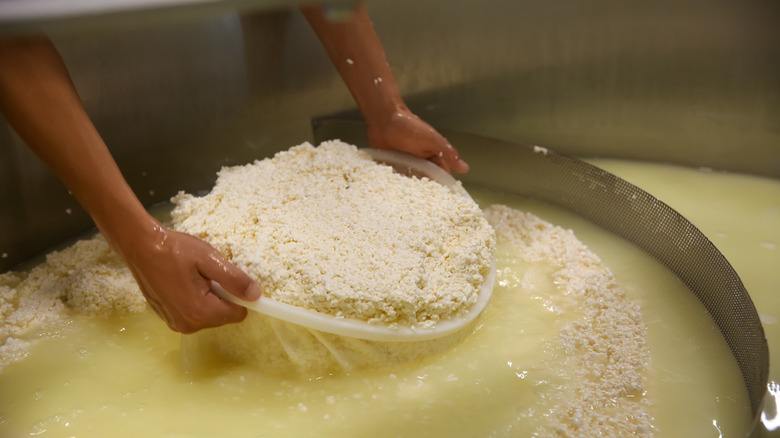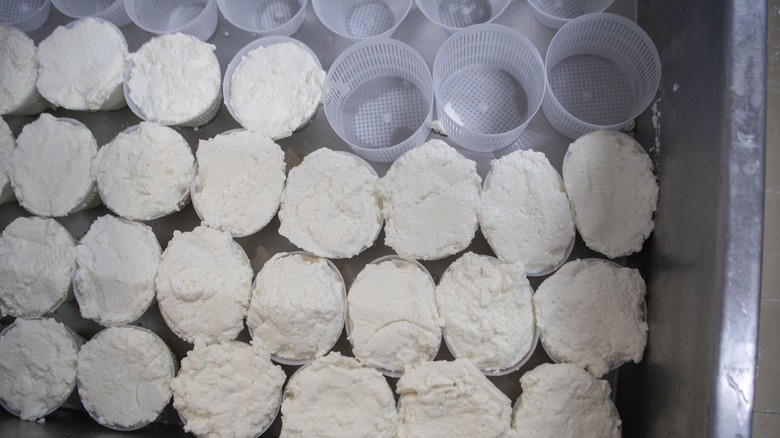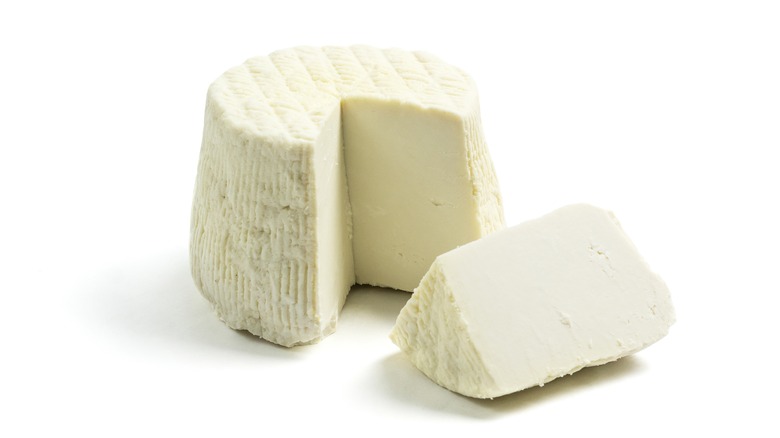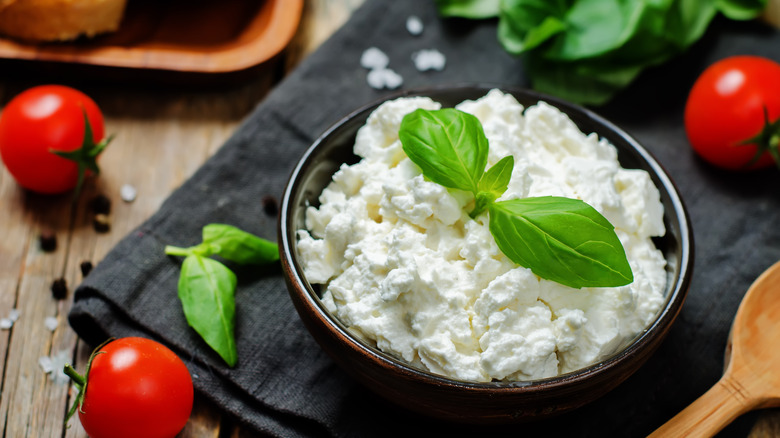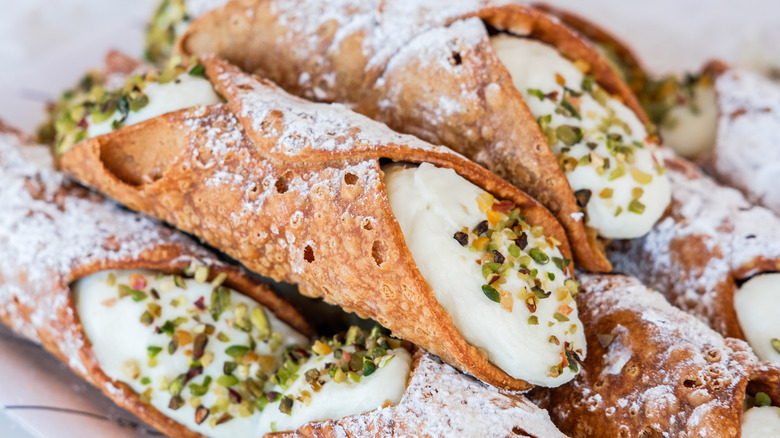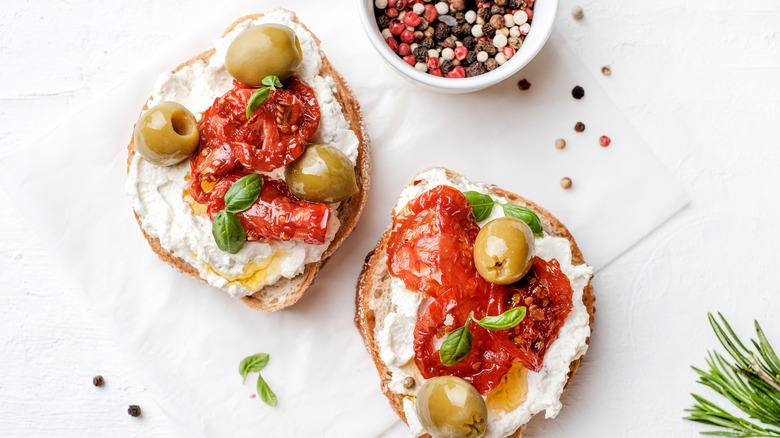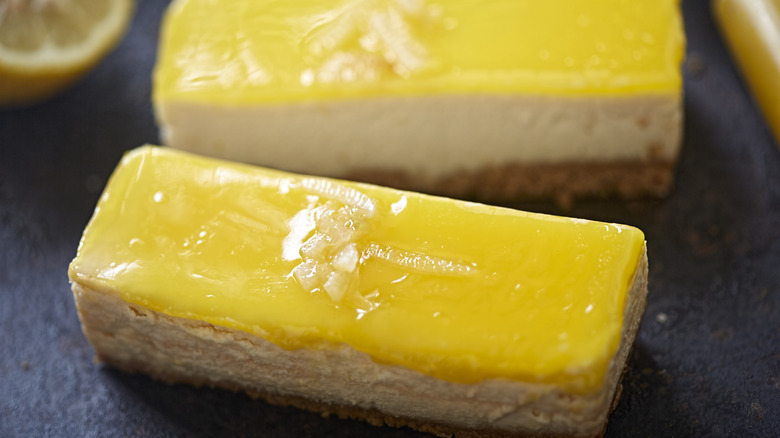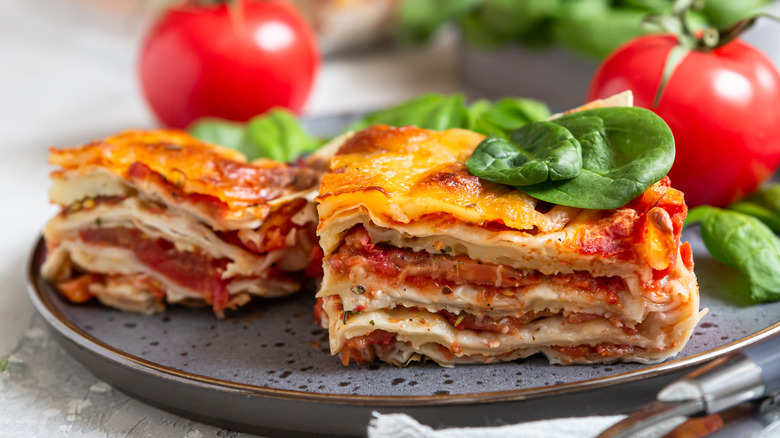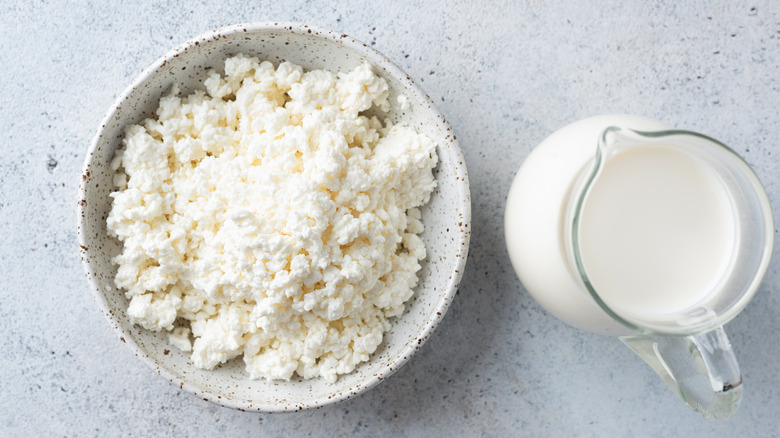Everything You Need To Know About Ricotta
Don't confuse ricotta with cottage cheese or other types of cheese. Although it's similar to many other dairy products, ricotta is something unique. Made up of small, delicate grains, ricotta has a light and airy texture and taste, creamy and milky without being heavy or dense. Ricotta's mild flavor and soft consistency allow it to be extremely versatile, its richness providing a balancing counterpoint to bolder ingredients. That is why in Italy, where ricotta originated, you'll find it paired marvelously with everything from salty cured meats and tangy tomato sauce, to crispy pastries and sweet candied fruit peel.
With its long history, impressive versatility, and surprisingly simple recipe, there's more to this soft, creamy dairy product than you might realize. Here's everything you need to know about ricotta: what it is, where it comes from, and how to make, store, and use it. We'll also discuss ricotta's nutritional value, the different kinds of ricotta, and how you can substitute it if you need to.
Ricotta is not a cheese (technically)
Ricotta is called "cheese" so often that you might be puzzled to hear that it isn't technically considered cheese. That's because cheese is made from milk in its natural state, while ricotta is made from milk that has already undergone some processing. In cheesemaking, a coagulant such as acid or the animal protein rennet is added to heated milk and/or cream. This causes a chemical reaction in which caesin and other milk proteins coagulate along with fat into solids called curds. These are strained out, drained of moisture, and used to make cheese. The yellowish liquid leftover after removing the curds from the milk is called whey. Not all of the proteins in milk become part of the curds; whey contains whey proteins, which you might encounter in protein shakes and powdered supplements.
To make ricotta, liquid whey is boiled again without additional coagulant. The heat causes the remaining whey proteins to form curds, which are typically smaller and finer than those produced in the first round. The curds were removed in this second round of straining to make up ricotta. This process of production gives ricotta its name, which is Italian for "recooked" or "cooked again." Nowadays, dried whey protein powder, or a mixture of whey and milk, may also be used in commercial ricotta production instead of fresh liquid whey.
Ricotta is a byproduct of cheesemaking
So what is ricotta exactly, if it's not cheese? The Italian term for such dairy byproducts is latticinio, which is also the name for a milky-white type of glass used in Venetian glassblowing. Ricotta was likely invented by cheesemakers as a means of preserving every bit of nutritional value from milk and is often made using the leftovers of the cheesemaking process. This means ricotta can be made from any kind of milk used in cheesemaking, such as cow, goat, sheep, or water buffalo, or a blend of different kinds of milk.
The cheeses most similar to ricotta are broadly called farmer's cheese or fresh cheese because they are not further aged after straining the curds. These cheeses can vary widely in appearance, moisture content, and consistency, and may or may not contain salt. Cottage cheese, the fresh cheese most frequently confused with ricotta, is a semiliquid mixture of partly-strained curds and whey, sometimes with cream added to improve the texture. The curds in cottage cheese are typically larger and firmer than those found in ricotta, while the overall texture of ricotta is drier and more uniform. Ricotta also tends to contain less salt but more fat than cottage cheese, making them different in flavor.
Ricotta has cousins outside Italy
We've already discussed the difference between cottage cheese and ricotta, but there are other dairy products with a resemblance to ricotta that originate outside Italy. Many of these can be described as "whey cheeses," since they resemble cheese but are made mostly from whey (milk is often added to whey in modern commercial ricotta production). The closest in name to ricotta is Portuguese and Brazilian requeijão, although it doesn't mean "recooked," but something like "re-cheesed." Called requesón in Spanish, this dairy product typically has a more liquid consistency than ricotta and may have a more sour flavor. It's made by adding additional milk (no more than 10%) to whey, which is only sometimes a part of the modern ricotta-making process. Greek manouri is also made by adding milk or cream to whey. In Scandinavia, whey is cooked with cream slowly over low heat until the natural sugars caramelize and darken, creating a whey cheese with a caramel-like color and flavor called brunost (brown cheese).
French brousse and Corsican brocciu are also produced from the whey of sheep's or goat's milk. Another close relative of Italian ricotta is urda, produced in Balkan countries like Romania. Like ricotta, urda can be made from pure whey, is used in both desserts and savory dishes, and also exists in a drier, salted form. In West and Central Asia, whey is preserved in other ways, for example by drying the solids into a product called kashk or qurut.
There are different kinds of ricotta
In Italy, most ricotta is produced by cheesemakers in the south of the country, but the type of milk used to make it varies. Ricotta's DOP (protected designation of origin) covers broad areas rather than being restricted to a particular spot. In Campania, ricotta is made as a byproduct of the famous water buffalo milk mozzarella. Cow's milk ricotta is made from the whey of cheeses like Taleggio and provolone; sheep's milk ricotta, which was the earliest type produced in Italy, uses the whey leftover from making pecorino Romano. Adding milk to whey to produce ricotta, instead of making it from pure whey, has become increasingly common, partly due to increased demand and partly because of how it changes the final product. The addition of milk or cream raises the fat content of the ricotta and gives it a richer texture.
Ricottas are made with both skim and whole milk; "whole milk ricotta" is made with typically 10% fat, according to the USDA. In the U.S., commercially produced ricotta is typically made from cow's milk and whey and has a relatively dense, wet texture. This is due to binding agents, which solidify the ricotta without most of the water is removed. The structure of this ricotta holds up well in dishes like lasagna. Smoother "artisanal" styles of ricotta are better suited to desserts. In Italy, the whipped ricotta used specifically for making sweet pastries like cannoli is called ricotta impastata.
It can be aged
Ricotta fresca (fresh ricotta) is the best-known type, but there are also ricottas that are aged and preserved. Each lends a distinctive flavor that makes it unique from the other varieties, and they are not interchangeable. Sheep's milk ricotta is salted, pressed of most of its moisture, and aged for 90 days to produce ricotta salata. It means salted ricotta, which has a dense, solid texture and a briny flavor reminiscent of feta cheese, though it is slightly drier and firmer than feta and can be grated rather than crumbled. Like feta, ricotta salata makes a great addition to salads, though it can also be grated over pasta. With the addition of red pepper flakes, it becomes spicy ricotta salata al peperoncino.
In the southern Italian region of Calabria, ricotta is smoked to make ricotta affumicata, giving it a flavor similar to that of smoked cheeses. This is another type of ricotta that's firm and dry enough to be grated over dishes as desired. Softer and more spreadable is the ricotta forte ("strong ricotta") of Gravina, a city in the southern Italian region of Puglia. This pungent ricotta is aged for months to years, giving it a scent and flavor similar to blue cheese.
Ricotta has an ancient history
Before modern refrigeration, dairy had to be either consumed fresh in its place of origin or preserved by being salted and/or aged for storage and transport. This means that historically, aged cheese was exported to urban markets, but ricotta and fresh cheese were countryside foods, primarily consumed by the people who made them and raised the milk-producing animals. Roman and Medieval cookbooks, which skew towards the cuisine of the urban elite, do not make much mention of ricotta, but it is referenced in Roman manuals on agriculture that describe the cheesemaking process. Cato the Elder's De agricultura, written in the 2nd century B.C.E., includes several recipes for rustic country dishes, including savillum: a cheesecake made with ricotta or fresh cheese mixed with flour, egg, and honey, which is baked and topped with more honey and poppyseeds.
In "Cheese and Culture," Paul Kindstedt writes that ricotta production first became a major part of agriculture in the Italian peninsula during the 2nd millennium B.C.E. Pigs were kept in smaller numbers alongside milk-producing goats, sheep, and cows, and the pigs were fattened on the final remnant of the whey leftover from making ricotta: a synergistic bond between swine-herding and cheesemaking established in the Bronze Age and still continued today by some European cheesemakers. Many of the techniques used to produce ricotta in Italy have changed little since ancient times, though traditional ceramic boilers, still in use as recently as the 19th century, have now been replaced by metal.
It is used in both sweet and savory dishes
The culinary applications for ricotta are endless. Ricotta's mild milkiness pairs well with a punchy wine full of bold flavor, and with contrasting salty, sweet, or sour ingredients. In Italy, ricotta is traditionally spread on toasted bread with honey and fruit such as figs, either raw or baked until it becomes soft and runny inside with a golden crust on top, a dish known as ricotta infornata ("oven-baked") or tricotta, because it has technically been cooked a third time. Ricotta is also stuffed into filled pasta like lasagna, ravioli, and manicotti, and gnocchi can be made with ricotta worked directly into the dough. Pizzas and flatbreads can be baked with ricotta on top, and it can be used in salads, as a sandwich spread, or to add a delicate creaminess to sauces or egg dishes like omelets and quiche.
When combined with sugar, ricotta also has many uses in desserts. Less dense and heavy than cream cheese or the Italian sweet cheese mascarpone, ricotta is a key ingredient in the filling for Sicilian cannoli and some other Italian pastries. Baked ricotta cheesecake is a classic, with a lighter texture than other types of cheesecake; you can also try it in other baked desserts like ricotta beignets.
Ricotta has health benefits
The nutritional value of ricotta is different from that of milk-based cheese, which can make ricotta a healthier choice than other dairy products. Compared with most other cheeses, ricotta contains less salt and less fat; about 10% fat, of which 8% is saturated, according to Heart Matters. Ricotta made with milk, especially whole milk ricotta, contains more fat than traditional whey ricotta.
Ricotta is rich in a variety of nutrients, including calcium, vitamin B12, phosphorus, the antioxidant mineral selenium, and protein. One 50-gram serving of ricotta contains 3.77 grams of protein, and ricotta is considered a "complete protein" food because it contains all essential amino acids (recall that the whey proteins which make up an essential component of ricotta are also used in supplements because of their assistance in building muscle). Ricotta is low in the milk sugar lactose and the milk protein caesin, which is removed in the initial straining of the curds, which means that people sensitive to caesin and lactose may find ricotta easier to digest than other dairy products.
You can (and should) make your own ricotta
Ricotta is astonishingly easy to make at home, as it can be produced in a matter of minutes. You can make homemade ricotta directly from milk, or you can go the traditional route and make it from whey. Heat is all that is actually required to curdle whey into ricotta, but many recipes will suggest adding a coagulant such as lemon juice or vinegar to help the process along. If you want to make ricotta from pure whey, you will need a coagulant anyway, so you can extract the curds from the milk separately before making the ricotta. Milk tends to boil over and burn easily, so be careful when heating it on the stove, and stir frequently.
Ricotta-making works best with whole milk, as skimmed milk may not have enough remaining fat content. A ½ gallon of milk will make approximately 2 cups of ricotta, depending on how much moisture is strained out of it. Compared to homemade ricotta, ricotta from the grocery store has a heavier, wetter texture; this is because stabilizers and thickeners are added to solidify the ricotta without draining all of the water. By making ricotta yourself, you can control the amount of moisture and create a final product with a light but still sturdy texture.
How to store it
Ricotta tastes best when fresh, and it's highly perishable, especially when homemade. Homemade ricotta only lasts a few days, so make it right before you plan to use it, and avoid making more than your recipe will require. Store-bought ricotta can be stored in a sealed container for up to one or two weeks, as long as it is kept refrigerated throughout. Ricotta should be discarded if it develops mold or if its color changes from pure white to yellowish. Like other foods, ricotta should also be discarded if left out at room temperature for longer than two hours.
Ricotta can be frozen in sealed bags for up to six months, although this may have an impact on its texture and flavor, especially after three months. Note that ricotta that has been thawed is best suited for cooked dishes rather than raw. Foods like filled pasta that contain a ricotta filling can also be frozen.
You can use substitutes for ricotta
The right substitute for ricotta depends on how you are using it in a recipe. This is especially true when it comes to moisture content since this can vary from one dairy product to another, and even between different batches of ricotta (another reason to make your own ricotta). If you don't eat dairy, coconut cream, cashew cream or soft tofu can be used in some recipes in place of ricotta. Firmer tofu, with its more crumbly texture, can also be used as a ricotta substitute in toppings and fillings.
As for substituting other dairy products, for savory recipes, you can try a fresh (unaged) cheese such as goat cheese, cottage cheese, or Mexican queso fresco. Note that these have a similar texture and flavor to ricotta, but are often saltier. You may wish to drain moisture from the cottage cheese, and, as the curds are larger than those found in ricotta, blending the cheese may help provide a closer texture. In desserts, cream cheese and mascarpone will work similarly to ricotta but are denser and higher in fat. Crème frâiche and sour cream can also the same richness and moisture to baked goods as ricotta, but will impart a slightly tangy flavor. And, of course, you can always use homemade ricotta if you have the opportunity to make this fascinating whey cheese yourself.
